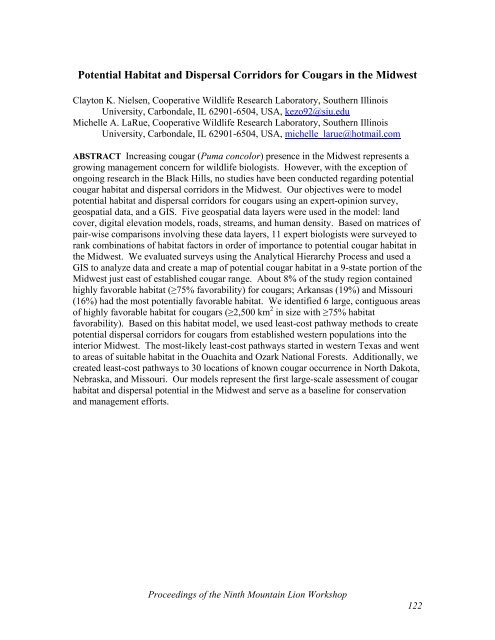Proceedings of the Ninth Mountain Lion Workshop - Carnivore ...
Proceedings of the Ninth Mountain Lion Workshop - Carnivore ...
Proceedings of the Ninth Mountain Lion Workshop - Carnivore ...
Create successful ePaper yourself
Turn your PDF publications into a flip-book with our unique Google optimized e-Paper software.
Potential Habitat and Dispersal Corridors for Cougars in <strong>the</strong> Midwest<br />
Clayton K. Nielsen, Cooperative Wildlife Research Laboratory, Sou<strong>the</strong>rn Illinois<br />
University, Carbondale, IL 62901-6504, USA, kezo92@siu.edu<br />
Michelle A. LaRue, Cooperative Wildlife Research Laboratory, Sou<strong>the</strong>rn Illinois<br />
University, Carbondale, IL 62901-6504, USA, michelle_larue@hotmail.com<br />
ABSTRACT Increasing cougar (Puma concolor) presence in <strong>the</strong> Midwest represents a<br />
growing management concern for wildlife biologists. However, with <strong>the</strong> exception <strong>of</strong><br />
ongoing research in <strong>the</strong> Black Hills, no studies have been conducted regarding potential<br />
cougar habitat and dispersal corridors in <strong>the</strong> Midwest. Our objectives were to model<br />
potential habitat and dispersal corridors for cougars using an expert-opinion survey,<br />
geospatial data, and a GIS. Five geospatial data layers were used in <strong>the</strong> model: land<br />
cover, digital elevation models, roads, streams, and human density. Based on matrices <strong>of</strong><br />
pair-wise comparisons involving <strong>the</strong>se data layers, 11 expert biologists were surveyed to<br />
rank combinations <strong>of</strong> habitat factors in order <strong>of</strong> importance to potential cougar habitat in<br />
<strong>the</strong> Midwest. We evaluated surveys using <strong>the</strong> Analytical Hierarchy Process and used a<br />
GIS to analyze data and create a map <strong>of</strong> potential cougar habitat in a 9-state portion <strong>of</strong> <strong>the</strong><br />
Midwest just east <strong>of</strong> established cougar range. About 8% <strong>of</strong> <strong>the</strong> study region contained<br />
highly favorable habitat (≥75% favorability) for cougars; Arkansas (19%) and Missouri<br />
(16%) had <strong>the</strong> most potentially favorable habitat. We identified 6 large, contiguous areas<br />
<strong>of</strong> highly favorable habitat for cougars (≥2,500 km 2 in size with ≥75% habitat<br />
favorability). Based on this habitat model, we used least-cost pathway methods to create<br />
potential dispersal corridors for cougars from established western populations into <strong>the</strong><br />
interior Midwest. The most-likely least-cost pathways started in western Texas and went<br />
to areas <strong>of</strong> suitable habitat in <strong>the</strong> Ouachita and Ozark National Forests. Additionally, we<br />
created least-cost pathways to 30 locations <strong>of</strong> known cougar occurrence in North Dakota,<br />
Nebraska, and Missouri. Our models represent <strong>the</strong> first large-scale assessment <strong>of</strong> cougar<br />
habitat and dispersal potential in <strong>the</strong> Midwest and serve as a baseline for conservation<br />
and management efforts.<br />
<strong>Proceedings</strong> <strong>of</strong> <strong>the</strong> <strong>Ninth</strong> <strong>Mountain</strong> <strong>Lion</strong> <strong>Workshop</strong><br />
122
















